Iona Bate – Inversanda Farm
This is the guard at our gate – exceptional for being both decorative and practical.
Pat McKrill (after identifying for us) had this to add: ” Your snake – correctly i.d’d – looks very satisfied with itself. Seems to have had an early season start in the food queue! No question, the season has started and – along with the snakes – I’m delighted. Roll on summer.”
Jen Fly – Kildaragh Farm
There seems to be a dearth of wildlife on Kildaragh, and this is all I could come up with. The lizards on our sunny back veranda love a mealworm during the lean winter months.
Common Coral tree (Erythrina lysistemon), coming into flower. It’s not a mist belt tree but was planted , I’m told by June Fannin, who was around many years ago. She owned this property and loved trees and all the old , tall ones were no doubt planted by her. This Coral tree is, at least 30 ft high. The Sunbirds and Black-headed Orioles love it.
Barry & Rose Downard – Oak Tree Cottage
Saw this lovely little green fella outside my workshop.
Other than that, amongst the usual suspects, we’ve spotted slender mongoose, a samango foraging our old pumpkins and oranges (food must be scarce in the forest), hooded eagles, gymnogene creating much angst with the resident hadedas, rock pigeons enacting some sort of rock pigeon soap opera with nestlings apparently being kicked out… the poor little ones battling to deal with the cold and damp, and at least one succumbing.
Robin and Sharon Barnsley
I have been away but I gather that Nikki will send you a picture of a Serval which we saw outside our lounge window one evening. It was standing its ground against our dogs, who had clearly decided that discretion was better than valour, and casually made its way up into a tree. There have been numerous sightings of serval, far more than usual, on the D17 over the past fortnight.
Tiffany Attwell – Horse Play, Old Kilgobbin Farm
Saw banded mongoose today!! He was rather large. And two reed buck and I think an oribi?
Ashley Crookes – Copperleigh Farm
Inhlosane was burnt this week, as was quite a bit of the Dargle and surrounding areas after the recent rains.
…but in other areas at least the grass is starting to recover in the firebreaks
And the insects are out busy pollinating the flowers and fruit trees (I’m sure Trevor Pye will be very happy about this!)
And finally I managed to photograph some Yellow Everlastings whilst taking the dogs for their afternoon walk in the veld.
Pat and Sandra Merrick – Albury Farm
With additional images from Dr Amy Shuttleworth (Trail Cam Pics)
As we were away for most of august, have nothing to report, just the pics I took below during july and beginning of august. The water buck are still around and our house sitter said he saw a female grysbok. Not sure if they are found in this area! Another interesting thing is that I looked up my pics of Tanzania and found that the water buck there, do not have the “white toilet” rump. Never knew that they differed.
Pat set the trail camera up next to the gate in the stone wall – as you will see from the trail photos below, a lot of animals use this gate for entry, eg: genet
Neville van Lelyveld : Farm Report for Iain Sinclair, Benn Meadhon Farm
Oribi
On Saturday Morning we were delighted to 5 of the original 9 oribi in the oribi paddock. Until now the most we have sighted was 3.
Reedbuck
It was very pleasing to see that during this weekend we managed to get a count of 27 reedbuck on the rye grass on Saturday night. There has been a steady increase in their numbers since the February disaster which seemed to have removed all the reedbuck from the farm. The new reedbucks currently on the farm are a completely new herd as their habits, characteristic, features, tracks, ages and habitats have all changed radically from the previous lot of reedbuck that were on the farm prior to February of this year.
Grey duiker
The duiker population on the farm has also under gone a 100% change in animals from February until now. There are also a lot less duiker around. On Saturday morning whilst waiting for the poachers to come in on the top of the hill on the non-agricultural side of the farm an adult male duiker came within a metre of us and stood over us looking at us while we were lying in the grass, even when we sat up he did not move off or feel threatened as he stood and watched us for about 3 minutes until he slowly started grazing and moved off slowly total unthreatened by our presence. This was a very special moment for us to experience this close a contact with this duiker. Somehow we never seem to have camera handy to capture these moments. Sadly however this will probably result in a very sad ending for him if he does not learn fear for humans. Sadly only 5 duiker were seen over this last weekend.
Blue Crane
A single blue crane was seen on Saturday.
Grey Crowned Cranes
Three crowned cranes were sighted on Saturday morning in the vlei. This is the first time we have seen these crowned cranes on the farm.
Forest Canaries
During our visit we saw a large flock of Forest Canaries in a tree. What a pretty little bird with such an amazing little song.
Spur-winged Geese
As previously reported the spurwing geese appear to be on the increase. During our visit we counted some 20 spurwing geese on the dam. This was great to see particularly with the presence of the Canadian geese on the dam.
Olive Thrush
There is still a lot of Olive thrushes on the farm, but once again there is a definite reduction in their number over previous visits.
Jackal Buzzards
Several Jackal buzzards can be seen almost anywhere on the farm. The sighting of these raptors seems to have increased. We were even privileged enough to see a juvenile Jackal Buzzard still most of his baby feathers on the fence above the maize paddocks. He then decided that playing with the crows was great fun; however the crow did not seem to agree. He flew around with them for ages either confused that he too was a crow or maybe he just enjoyed the reaction he got from them.
Nikki Brighton – Old Kilgobbin
At this time of year there seem to be so many birds about. I suppose they are searching for food and water in the gentler climates of gardens. Lots of nest building, bathing and foraging for food right beside my cottage, which is a delight to observe.
Walks in recently burned areas are full of little treats too. Just when one begins to wonder if anything could survive, the tiny yellow flowers of Cyrtanthus breviflorus (Yellow Fire Lily) poke cheerfully out of the charcoal grassland. The bulbs lie dormant buried under the ground, surviving the heat of the fires and emerging triumphantly when all is calm.
Interestingly, Conostomium natalensis (known as the lightning plant) which flowers in shady spots for most of summer and autumn, has just turned a dark chocolate colour, not burnt to the ground.
Rocks, usually hidden by bracken and shrubs are revealed. These ones standing taller than me.
With just a little moisture in the mornings, the tiny bird like Bracken fronds begin to unfurl.
I spotted a serval running across the hillsides one afternoon, have heard the Tree Hyrax calling, there have been Common Duiker and Bushbuck, a couple of Reedbuck and a single Oribi about too. Certainly, all hoping for something green to eat to emerge from the ashes soon.
The grey leaves of Buddleja dysophylla (White Climbing Sagewood) found scrambling along forest margins appear to glow in the early morning light.









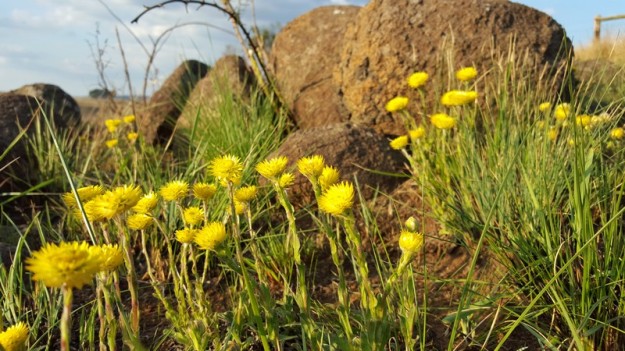

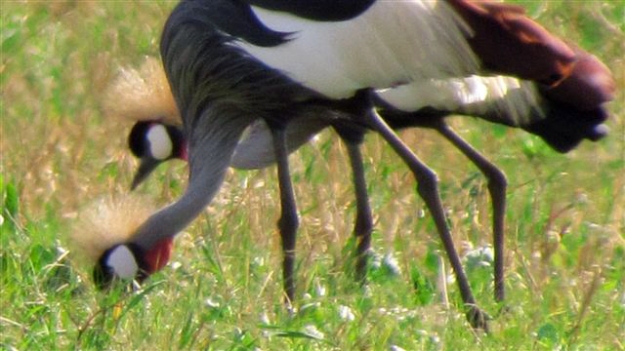












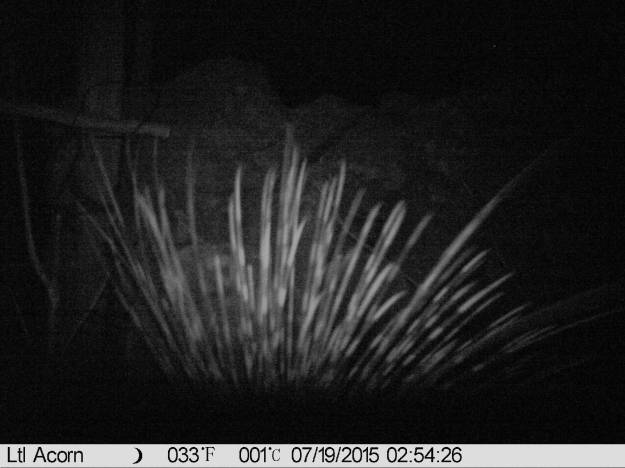


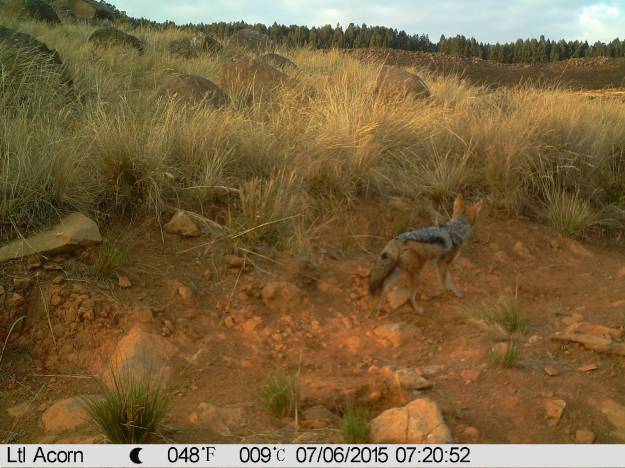



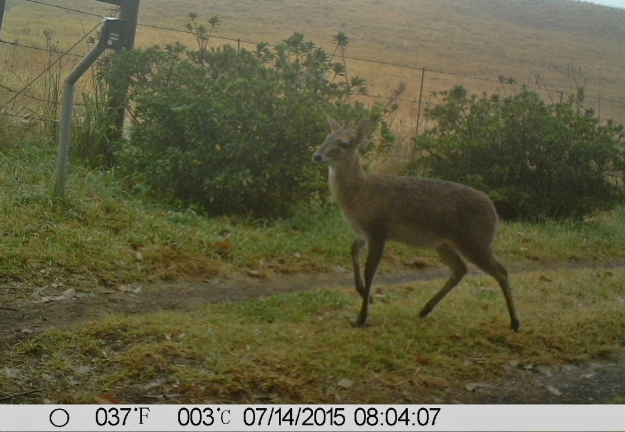






Magnificent photos and sightings. This record is reason enough for living in Africa, particularly your part of Africa
LikeLike
Very interesting sightings and comments again from everyone. You certainly have a way with words Nikki ….re the little yellow fire lilies life story!
LikeLike